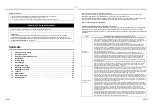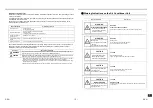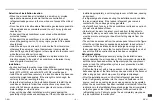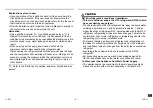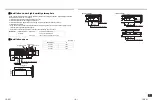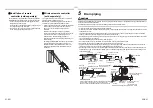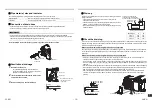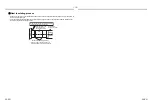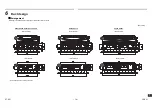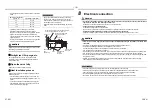
– 4 –
EN
Selection of installation location
• When the air conditioner is installed in a small room, provide
appropriate measures to ensure that the concentration of
refrigerant leakage occur in the room does not exceed the critical
level.
• Do not install in a location where flammable gas leaks are possible.
If the gas leak and accumulate around the unit, it may ignite and
cause a fire.
• To transport the air conditioner, wear shoes with additional
protective toecap.
• To transport the air conditioner, do not take hold of the bands
around the packing carton. You may injure yourself if the bands
should break.
• Install the indoor unit at least 2.5 m above the floor level since
otherwise the users may injure themselves or receive electric
shocks if they poke their fingers or other objects into the indoor unit
while the air conditioner is running.
• Do not place any combustion appliance in a place where it is
directly exposed to the wind of air conditioner, otherwise it may
cause imperfect combustion.
Installation
• Suction duct length must be longer than 850mm.
• When the indoor unit is to be suspended, the designated hanging
bolts (M10 or W3/8) and nuts (M10 or W3/8) must be used.
• Install the air conditioner securely in a location where the base can
sustain the weight adequately. If the strength is not enough, the
unit may fall down resulting in injury.
• Follow the instructions in the Installation Manual to install the air
conditioner. Failure to follow these instructions may cause the
product to fall down or topple over or give rise to noise, vibration,
water leakage or other trouble.
• Carry out the specified installation work to guard against the
possibility of high winds and earthquake. If the air conditioner is not
installed appropriately, a unit may topple over or fall down, causing
an accident.
• If refrigerant gas has leaked during the installation work, ventilate
the room immediately. If the leaked refrigerant gas comes in
contact with fire, noxious gas may generate.
• Use forklift truck to carry in the air conditioner units and use winch
or hoist at installation of them.
• Helmet must be worn to protect your head from falling objects.
Especially, when you work under an inspection opening, helmet
must be worn to protect your head from falling objects from the
opening.
• The unit can be accessed from the service panel shown in the figure.
• After the unit has been suspended and installed, take dust-proof
measures for the air intake and air discharge openings (cover
these openings) to ensure that no dust will enter inside the unit at
any point until the construction work has been completed.
Refrigerant piping
• Install the refrigerant pipe securely during the installation work
before operating the air conditioner. If the compressor is operated
with the valve open and without refrigerant pipe, the compressor
sucks air and the refrigeration cycles is over pressurized, which
may cause an injury.
• Tighten the flare nut with a torque wrench in the specified manner.
Excessive tighten of the flare nut may cause a crack in the flare nut
after a long period, which may result in refrigerant leakage.
• After the installation work, confirm that refrigerant gas does not
leak. If refrigerant gas leaks into the room and flows near a fire
source, such as a cooking range, noxious gas may be generated.
• When the air conditioner has been installed or relocated, follow the
instructions in the Installation Manual and purge the air completely
so that no gases other than the refrigerant will be mixed in the
refrigerating cycle. Failure to purge the air completely may cause
the air conditioner to malfunction.
7-EN
8-EN


